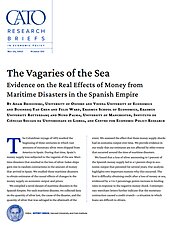We compiled a novel dataset of maritime disasters in the Spanish Empire. For each maritime disaster, we collected data on the quantity of silver lost, the cause of the disaster, and the quantity of silver that was salvaged in the aftermath of the event. We assessed the effect that these money supply shocks had on economic output over time. We provide evidence in our study that our estimates are not affected by other events that occurred around the time of maritime disasters.
We found that a loss of silver amounting to 1 percent of the Spanish money supply led to a 1 percent drop in economic output that persisted for several years. Our analysis highlights two important reasons why this occurred. The first is difficulty obtaining credit after a loss of money at sea, evidenced by a 1 to 2 percentage points increase in lending rates in response to the negative money shock. Contemporary merchant letters further indicate that the monetary contraction caused a credit crunch—a situation in which loans are difficult to obtain.
The second reason is rigidity of prices; we found that prices responded only sluggishly to losses of money at sea. Economic output fell because the prices of goods and services did not decrease immediately to match the contracted money supply. In contrast, changes in wages were generally more responsive to contractions of the money supply, though more so for unskilled than for skilled labor.
Further research indicates that the response of the Spanish economy was influenced by the putting-out system, in which merchants supplied manufacturers with raw materials and other inputs to production. Merchants’ ability to raise the money necessary to supply input goods to manufacturers was negatively affected by disaster-induced credit crunches. Consistent with this, input prices declined more markedly than output prices in the aftermath of maritime disasters. In addition, the textile industry, whose reliance on merchants for the provision of input goods was particularly pronounced, experienced especially large output declines.
NOTE
This research brief is based on Adam Brzezinski et al., “The Vagaries of the Sea: Evidence on the Real Effects of Money from Maritime Disasters in the Spanish Empire,” Review of Economics and Statistics, July 2022.

